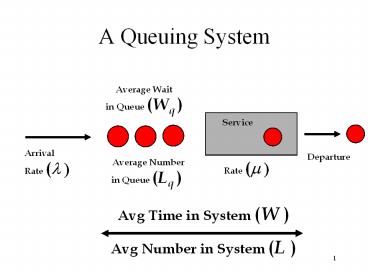A Queuing System - PowerPoint PPT Presentation
Title:
A Queuing System
Description:
Capacity problems are very common in industry and one of the ... Several medium-length lines are less intimidating than one very long line. Guarantees fairness ... – PowerPoint PPT presentation
Number of Views:1106
Avg rating:3.0/5.0
Title: A Queuing System
1
A Queuing System
Average Wait in Queue (Wq )
Arrival Rate (???
Departure
Average Number in Queue (Lq )
Rate (???
Avg Time in System (W ) Avg Number in System (L )
2
Why is Queuing Analysis Important?
- Capacity problems are very common in industry and
one of the main drivers of process redesign - Need to balance the cost of increased capacity
against the gains of increased productivity and
service - Queuing and waiting time analysis is particularly
important in service systems - Large costs of waiting and of lost sales due to
waiting - Prototype Example ER at County Hospital
- Patients arrive by ambulance or by their own
accord - One doctor is always on duty
- More and more patients seeks help ? longer
waiting times - Question Should another MD position be instated?
3
Examples of Real World Queuing Systems?
- Commercial Queuing Systems
- Commercial organizations serving external
customers - Ex. Dentist, bank, ATM, gas stations, plumber,
garage - Transportation service systems
- Vehicles are customers or servers
- Ex. Vehicles waiting at toll stations and traffic
lights, trucks or ships waiting to be loaded,
taxi cabs, fire engines, elevators, buses - Business-internal service systems
- Customers receiving service are internal to the
organization providing the service - Ex. Inspection stations, conveyor belts, computer
support - Social service systems
- Ex. Judicial process, the ER at a hospital,
waiting lists for organ transplants or student
dorm rooms
4
Components of a Basic Queuing Process
Input Source
The Queuing System
Served Jobs
Service Mechanism
Calling Population
Jobs
Queue
leave the system
Queue Discipline
Arrival Process
Service Process
Queue Configuration
5
Principal Queue Parameters
- Calling Population
- Arrival Process
- Service Process
- Number of Servers
- Queue Discipline
6
1. The Calling Population
- Population of customers or jobs
- The size can be finite or infinite
- The latter is most common
- Can be homogeneous
- Only one type of customers/ jobs
- Or heterogeneous
- Several different kinds of customers/jobs
7
2. Arrival Process
- In what pattern do jobs / customers arrive to the
queueing system? - Distribution of arrival times?
- Batch arrivals?
- Finite population?
- Finite queue length?
- Poisson arrival process often assumed
- Many real-world arrival processes can be modeled
using a Poisson process
8
3. Service Process
- How long does it take to service a job or
customer? - Distribution of arrival times?
- Rework or repair?
- Service center (machine) breakdown?
- Exponential service times often assumed
- Works well for maintenance or unscheduled service
situations
9
4. Number of Servers
- How many servers are available?
Single Server Queue
Multiple Server Queue
10
Example Two Queue Configurations
11
Multiple v.s. Single Customer Queue Configuration
Multiple Line Advantages
Single Line Advantages
- The service provided can be differentiated
- Ex. Supermarket express lanes
- Labor specialization possible
- Customer has more flexibility
- Balking behavior may be deterred
- Several medium-length lines are less intimidating
than one very long line
- Guarantees fairness
- FIFO applied to all arrivals
- No customer anxiety regarding choice of queue
- Avoids cutting in problems
- The most efficient set up for minimizing time in
the queue - Jockeying (line switching) is avoided
12
5. Queue Discipline
- How are jobs / customers selected from the queue
for service? - First Come First Served (FCFS)
- Shortest Processing Time (SPT)
- Earliest Due Date (EDD)
- Priority (jobs are in different priority classes)
- FCFS default assumption for most models































